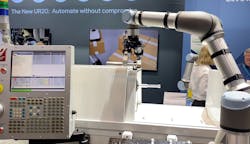When it comes to automating tasks, one of the first areas targeted tend to be repetitive tasks that require precision and dexterity. Machine tending, a typically repetitive and precise task, has largely remained a manual operation as robotic systems tended to be too expensive for such applications. But that has been changing with the introduction and spread of collaborative robots (cobots) across industry.
The lower price point of cobots, combined with their more intuitive programming requirements and ability to be moved where needed to work alongside humans with no protective fencing, has resulted in machine tending developing into a major application for cobots.
At IMTS 2022, Universal Robots showcased several machine tending applications developed by partners using Universal Robots’ cobots. In the accompanying video, machine tending applications from Robotiq and VersaBuilt are highlighted.
Nick Garcia with Robotiq said, “We really wanted to mimic the human experience with this [machine tending] solution by having it [the robot] do everything the operator does. But that's just one part of the puzzle. The other part of the solution is the software package which reduces the time that it takes to program the system by 65%. In just three steps the software will generate a template program by asking what type of operation is being performed—whether it's a mill or a lathe; then it prompts the user to program key waypoints within it; and then our Smart Moves software automatically programs the robot’s path based on those waypoints.”
Anders Beck with Universal Robots said this technology from Robotiq helps alleviate the issue of automating legacy machine operations. In the past, it often took several days for an electrician to really find their way into a legacy machine to connect, wire, and automate additional operations, he said. “Now you can simply mount it externally with the Robotiq system and automate a legacy machine in a very short time.”
Beck also highlighted a system from VersaBuilt for machine tending that makes it easier for machinists to change parts—an increasingly common task for high mix, low-volume manufacturers. He said that with machine tending systems such as this one and the one from Robotiq, cobots are essentially becoming tools for operators and machinists.
“With this flexible system (from VersaBuilt), it's possible for a machinist to retool the process frequently for many different parts,’ said Beck. “This frees up people from being tied to machine processes so they can, instead, be preparing new parts, replacing parts, or programming the robot for new parts.”
Leaders relevant to this article:


